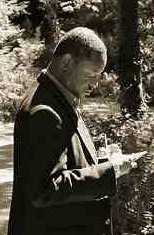
Kate MacQueen writes most of her poetry along New Hope Creek in North Carolina and the rest of it on airplanes and in hotels. She was a founding member of pinecone: the North Georgia Haiku Society and is a happy adoptee of the North Carolina Haiku Society. Her work has sporadically appeared in a variety of publications including Modern Haiku, The Heron's Nest, Frogpond, Acorn, Contemporary Haibun & Haiga and big sky: The Red Moon Anthology of English-Language Haiku. She was a runner-up in the Snapshot Press Haiku Calendar Competition in 2000 and 2008.
Hi Curtis,
After yet another wonderful evening hanging out with some North Carolina Haiku Society poets, I feel like I might be getting a handle on why I care about these little poems. I enjoy reading the responses to your three questions each week; thanks for keeping this feature going. All the best, Kate
1. Why do you write haiku?
Because the full moon shines above the last dark road to my house when I’m driving home from work in the winter and the next day I may need to drink from that light as from a pool of still water. Because each poem is as complete in itself as a butterfly rising to alight on a branch yet the poetry is egg, caterpillar, leaf, chrysalis, butterfly and once again egg. Because one-breath poetry demands that I breathe slow and deep. Because spending time with haijin clears my eyes when they are cloudy, my ears when they are ringing from the din, my heart when it is gritty with frustration. And because these haiku poets make me laugh.
2. What other poetic forms do you enjoy?
My love of poetry is eclectic. More than anything else, it is concise imagery and a sense of presence that draws me into a poem. At 15 it was Emily Dickenson’s “I’ll tell you how the sun rose, a ribbon at a time…” At 50 it was Mary Oliver’s “Raven with Crows.” In between it was Ntozake Shange, Fanny Howe, Frank O’Hara, Derek Walcott, Lawrence Ferlenghetti, among many others. It’s not surprising haiku appeals to me, it is surprising it took me four decades to pay it any serious attention.
3. Of the many wonderful haiku you've written, what do you consider to be your top three?
spring morning
last year’s new neighbor
introduces himself
The Heron’s Nest, Vol VIII, Number 3, Sept 2006
big sky: The Red Moon Anthology of English Language Haiku 2006 (Red Moon Press, 2007)
his song
where she said he would be
indigo bunting
Beneath the Willow Tree: Poems from the North Carolina Haiku Society (Rosenberry Books, 2007)
The Haiku Calendar 2009 (Snapshot Press, 2008)
nightfall
wingbeats of blackbirds
deep in the thicket
The Heron’s Nest, Vol III, Number 3, March 2001
If you've been enjoying this weekly series and have not contributed, please consider sharing your response (whether it be for haiku or tanka) to the three little questions that Kate answered. You must be a published poet in order to participate.
Neal Whitman will be our guest next week.












